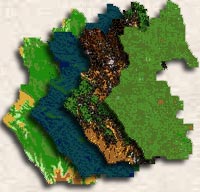|
|
Negotiation Courses Available for 2005
|
|
 Natural resource management, involving humans as it does, increasingly demands skills in negotiation to better involve the public in making decisions about trust resources. Based on research they have been conducting since the early 1980s, USGS scientists with the Policy Analysis and Science Assistance Branch of the Fort Collins Science Center annually offer two courses on natural resource negotiation. Both the Basic Natural Resource Negotiation and Advanced Natural Resource Negotiation courses are offered in collaboration with the USGS National Training Center. Participants in this year's Advanced course, held Sept. 14-16 in Fort Collins, represented the U.S. Fish and Wildlife Service, U.S. Bureau of Reclamation, National Park Service, and USDA Forest Service. On October 19-21, USGS scientists will conduct the Basic course for Seattle City Light employees. The Basic course will be offered again in Fort Collins during March and April 2005, and these courses are open to anyone. For more information on course content and schedules, or to register, please visit the site below or call Earlene Swann, 970-226-9346. Natural resource management, involving humans as it does, increasingly demands skills in negotiation to better involve the public in making decisions about trust resources. Based on research they have been conducting since the early 1980s, USGS scientists with the Policy Analysis and Science Assistance Branch of the Fort Collins Science Center annually offer two courses on natural resource negotiation. Both the Basic Natural Resource Negotiation and Advanced Natural Resource Negotiation courses are offered in collaboration with the USGS National Training Center. Participants in this year's Advanced course, held Sept. 14-16 in Fort Collins, represented the U.S. Fish and Wildlife Service, U.S. Bureau of Reclamation, National Park Service, and USDA Forest Service. On October 19-21, USGS scientists will conduct the Basic course for Seattle City Light employees. The Basic course will be offered again in Fort Collins during March and April 2005, and these courses are open to anyone. For more information on course content and schedules, or to register, please visit the site below or call Earlene Swann, 970-226-9346.
 2005 Negotiation Course Schedule 2005 Negotiation Course Schedule
|
Spotlight on Invasives
|
|
 Invasive species of plants, animals, diseases, and pathogens are estimated to cause more than $137 billion annually in damage to Americans in economic, ecological, and human health costs. Invasive species are best managed by preventing their establishment in the first place or by halting their spread to unaffected areas. But how? The USGS, NASA, and Colorado State University have teamed up to develop a tool to map invasive species and predict where they could be headed. This “ecological forecasting” model will help managers and policymakers recognize threats and set priorities for addressing them while control is still possible. The USGS has just launched a new “Research Spotlight” web feature describing the project, its development, and its management ramifications. The site, “Ecological Forecasting: A Strategic Partnership to Predict and Manage Biological Invasions,” includes example maps and model outputs as well as links to other pertinent sites. Invasive species of plants, animals, diseases, and pathogens are estimated to cause more than $137 billion annually in damage to Americans in economic, ecological, and human health costs. Invasive species are best managed by preventing their establishment in the first place or by halting their spread to unaffected areas. But how? The USGS, NASA, and Colorado State University have teamed up to develop a tool to map invasive species and predict where they could be headed. This “ecological forecasting” model will help managers and policymakers recognize threats and set priorities for addressing them while control is still possible. The USGS has just launched a new “Research Spotlight” web feature describing the project, its development, and its management ramifications. The site, “Ecological Forecasting: A Strategic Partnership to Predict and Manage Biological Invasions,” includes example maps and model outputs as well as links to other pertinent sites.
 Ecological Forecasting: A Strategic Partnership to Predict and Manage Biological Invasions Ecological Forecasting: A Strategic Partnership to Predict and Manage Biological Invasions
|
New Report on Monitoring Trends in U.S. Bat Populations
|
|
 The cryptic and nocturnal habits of bats render it difficult to assess trends in the status of their populations. To meet this challenge, USGS biologists Mike Bogan and Tom O'Shea hosted an expert workshop to examine the topic of monitoring the status of bat populations. The proceedings are contained in a newly released report, “Monitoring Trends in Bat Populations of the United States and Territories: Problems and Prospects,” Information and Technology Report USGS/BRD/ITR—2003-003. Part I of the report includes contributed papers that give an overview of past and current monitoring efforts, and a compilation and analysis of existing data on bat population trends in the U.S. and territories. In Part II, workshop participants provide critical analyses of problems in monitoring trends in bat populations along with recommendations for improving methods, defining objectives and priorities, and enhancing information exchange to facilitate future monitoring work. Hard copies are available from the editors. The cryptic and nocturnal habits of bats render it difficult to assess trends in the status of their populations. To meet this challenge, USGS biologists Mike Bogan and Tom O'Shea hosted an expert workshop to examine the topic of monitoring the status of bat populations. The proceedings are contained in a newly released report, “Monitoring Trends in Bat Populations of the United States and Territories: Problems and Prospects,” Information and Technology Report USGS/BRD/ITR—2003-003. Part I of the report includes contributed papers that give an overview of past and current monitoring efforts, and a compilation and analysis of existing data on bat population trends in the U.S. and territories. In Part II, workshop participants provide critical analyses of problems in monitoring trends in bat populations along with recommendations for improving methods, defining objectives and priorities, and enhancing information exchange to facilitate future monitoring work. Hard copies are available from the editors.
 View Publication: Monitoring Trends in Bat Populations of the United States and Territories: Problems and Prospects View Publication: Monitoring Trends in Bat Populations of the United States and Territories: Problems and Prospects
|
 Current News & Events
Current News & Events
|

